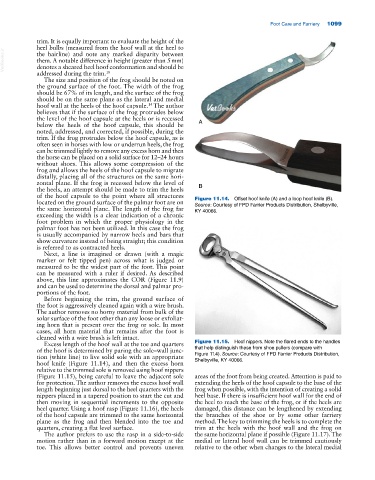Page 1133 - Adams and Stashak's Lameness in Horses, 7th Edition
P. 1133
Foot Care and Farriery 1099
trim. It is equally important to evaluate the height of the
heel bulbs (measured from the hoof wall at the heel to
VetBooks.ir them. A notable difference in height (greater than 5 mm)
the hairline) and note any marked disparity between
denotes a sheared heel hoof conformation and should be
addressed during the trim. 18
The size and position of the frog should be noted on
the ground surface of the foot. The width of the frog
should be 67% of its length, and the surface of the frog
should be on the same plane as the lateral and medial
hoof wall at the heels of the hoof capsule. The author
14
believes that if the surface of the frog protrudes below
the level of the hoof capsule at the heels or is recessed
below the heels of the hoof capsule, this should be A
noted, addressed, and corrected, if possible, during the
trim. If the frog protrudes below the hoof capsule, as is
often seen in horses with low or underrun heels, the frog
can be trimmed lightly to remove any excess horn and then
the horse can be placed on a solid surface for 12–24 hours
without shoes. This allows some compression of the
frog and allows the heels of the hoof capsule to migrate
distally, placing all of the structures on the same hori
zontal plane. If the frog is recessed below the level of
the heels, an attempt should be made to trim the heels B
of the hoof capsule to the point where all structures
located on the ground surface of the palmar foot are on Figure 11.14. Offset hoof knife (A) and a loop hoof knife (B).
Source: Courtesy of FPD Farrier Products Distribution, Shelbyville,
the same horizontal plane. The length of the frog far KY 40066.
exceeding the width is a clear indication of a chronic
foot problem in which the proper physiology in the
palmar foot has not been utilized. In this case the frog
is usually accompanied by narrow heels and bars that
show curvature instead of being straight; this condition
is referred to as contracted heels.
Next, a line is imagined or drawn (with a magic
marker or felt tipped pen) across what is judged or
measured to be the widest part of the foot. This point
can be measured with a ruler if desired. As described
above, this line approximates the COR (Figure 11.9)
and can be used to determine the dorsal and palmar pro
portions of the foot.
Before beginning the trim, the ground surface of
the foot is aggressively cleaned again with a wire brush.
The author removes no horny material from bulk of the
solar surface of the foot other than any loose or exfoliat
ing horn that is present over the frog or sole. In most
cases, all horn material that remains after the foot is
cleaned with a wire brush is left intact.
Excess length of the hoof wall at the toe and quarters Figure 11.15. Hoof nippers. Note the flared ends to the handles
of the hoof is determined by paring the sole–wall junc that help distinguish these from shoe pullers (compare with
tion (white line) to live solid sole with an appropriate Figure 11.4). Source: Courtesy of FPD Farrier Products Distribution,
hoof knife (Figure 11.14), and then the excess horn Shelbyville, KY 40066.
relative to the trimmed sole is removed using hoof nippers
(Figure 11.15), being careful to leave the adjacent sole areas of the foot from being created. Attention is paid to
for protection. The author removes the excess hoof wall extending the heels of the hoof capsule to the base of the
length beginning just dorsal to the heel quarters with the frog when possible, with the intention of creating a solid
nippers placed in a tapered position to start the cut and heel base. If there is insufficient hoof wall for the end of
then moving in sequential increments to the opposite the heel to reach the base of the frog, or if the heels are
heel quarter. Using a hoof rasp (Figure 11.16), the heels damaged, this distance can be lengthened by extending
of the hoof capsule are trimmed to the same horizontal the branches of the shoe or by some other farriery
plane as the frog and then blended into the toe and method. The key to trimming the heels is to complete the
quarters, creating a flat level surface. trim at the heels with the hoof wall and the frog on
The author prefers to use the rasp in a side‐to‐side the same horizontal plane if possible (Figure 11.17). The
motion rather than in a forward motion except at the medial or lateral hoof wall can be trimmed cautiously
toe. This allows better control and prevents uneven relative to the other when changes to the lateral medial

